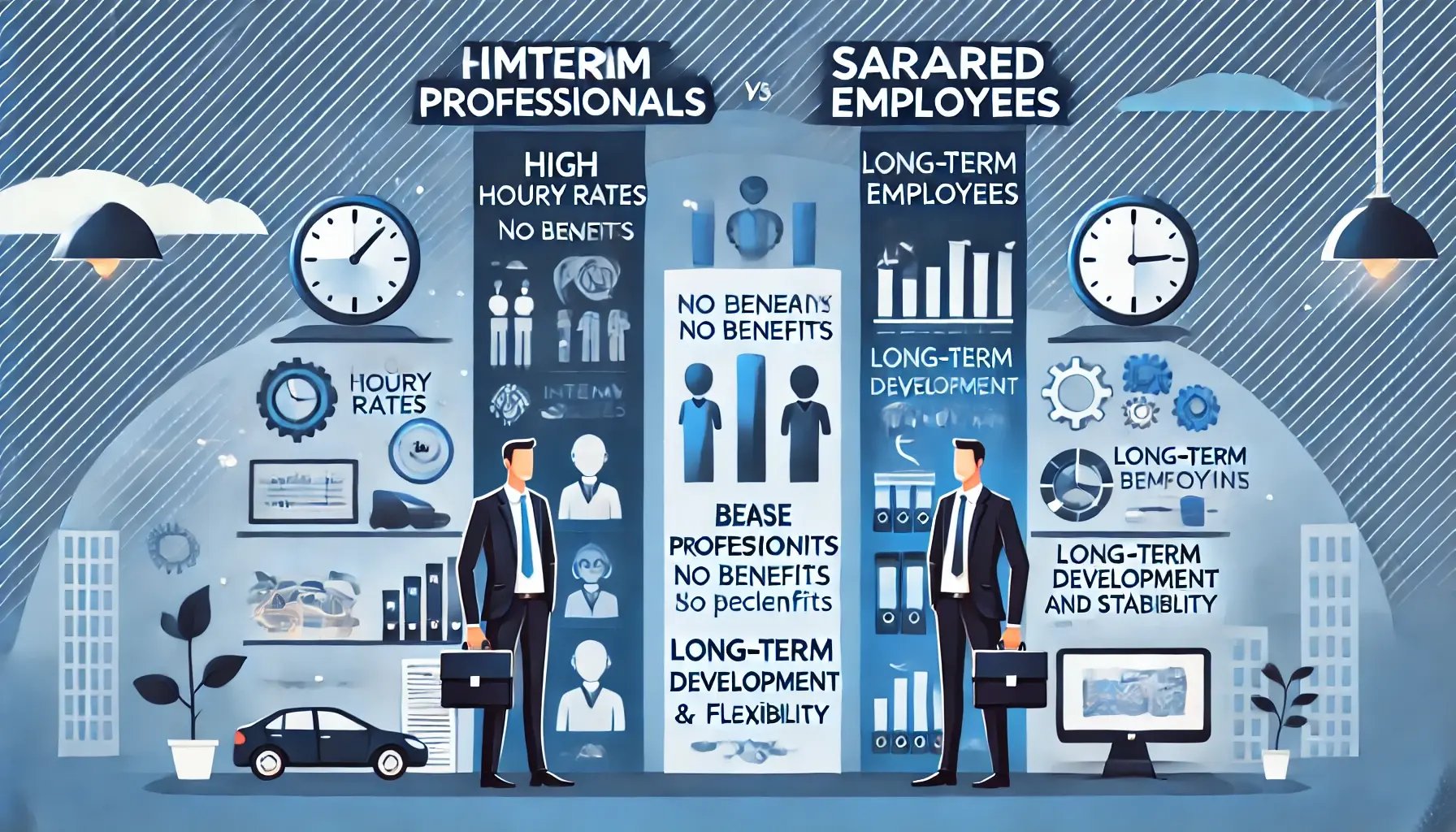Interim management is a unique field where professionals are brought in temporarily to manage a...
The Cost Dynamics of Hiring: Interim Professionals vs. Payroll Employees
 The Cost Dynamics of Hiring: Interim Professionals vs. Payroll Employees
The Cost Dynamics of Hiring: Interim Professionals vs. Payroll Employees
In today's dynamic business environment, organizations often face the challenge of deciding whether to hire interim professionals or bring someone onto the payroll. This decision is influenced by a variety of factors, including the specific needs of the organization, the nature of the role, and cost considerations. Understanding the cost dynamics between interim professionals and salaried employees is crucial for making an informed decision.
Understanding Interim Professional Fees
Interim professionals, also known as contractors or freelancers, are typically hired for their specialized expertise and the flexibility they offer. Their fee structure often reflects the temporary and highly skilled nature of their work.
- Higher Hourly/Daily Rates: Interim professionals often command higher hourly or daily rates compared to their salaried counterparts. For example, an interim manager might charge between €700 to €1,100 per day, depending on their experience and the industry.
- No Benefits Package: Unlike permanent employees, interim professionals do not receive benefits such as health insurance, retirement contributions, or paid time off. This lack of benefits is usually factored into their higher rates.
- Specialized Expertise: Interims are frequently brought in for their specialized knowledge and ability to handle specific projects or crises. Their expertise justifies the premium rates they charge.
Cost Components of Salaried Employees
Salaried employees are a long-term investment for any organization. The costs associated with employing someone on payroll go beyond their base salary, encompassing various benefits and long-term financial commitments.
- Base Salary: Salaried employees generally receive a lower base salary compared to the equivalent daily cost of an interim professional. For instance, a full-time manager might earn between €90,000 to €130,000 annually.
- Benefits and Perks: Employees on payroll typically receive a comprehensive benefits package, which can include health insurance, retirement plans, paid leave, bonuses, and other perks. These benefits can add 20-30% to the overall compensation cost.
- Long-term Development: Hiring full-time employees involves costs spread over a longer period, with a focus on developing in-house talent and fostering long-term stability within the organization.
Comparing Costs: An Example
To illustrate, consider the annual cost of employing a manager:
- Interim Manager: At a rate of €900 per day for a 250-day working year, the cost would be €225,000 annually. This excludes any benefits, which are typically not provided to interims.
- Salaried Manager: With a salary of €110,000 per year, plus benefits costing an additional 25%, the total annual cost would be €137,500. This includes benefits such as health insurance, retirement contributions, and paid leave.
Advantages of Hiring an Interim
- Immediate Availability: Interims can often start on short notice, providing a swift solution to urgent needs without the lengthy recruitment process. This is particularly valuable in situations where there is an unexpected vacancy or a sudden surge in workload.
- Specialized Skills: Interims bring specific expertise and experience that may not be available within the current team, allowing organizations to tackle complex projects effectively. This can be crucial for projects requiring niche skills or industry-specific knowledge.
- Flexibility: Hiring an interim professional offers flexibility in terms of contract length and scope of work, making it easier to scale up or down based on project needs. This adaptability is beneficial for managing fluctuating workloads and changing project requirements.
- Objective Perspective: As outsiders, interims can provide fresh, unbiased perspectives and innovative solutions that internal staff might overlook due to organizational familiarity. This can lead to new insights and improvements in processes and strategies.
- Cost Control: While interims may have higher daily rates, the overall cost can be controlled by limiting the duration of their engagement and avoiding long-term financial commitments associated with permanent hires. This is advantageous for budget-conscious organizations needing short-term expertise.
- Crisis Management: Interims are often experienced in handling crises and managing change, making them invaluable during periods of transition or organizational upheaval. Their ability to quickly assess situations and implement effective solutions can stabilize and steer organizations through turbulent times.
- Knowledge Transfer: Interim professionals can help upskill existing employees through knowledge transfer, leaving the organization in a stronger position once their contract ends. This ensures that the benefits of their expertise continue to be felt long after they have departed.
Strategic Considerations for Employers
- Short-Term vs. Long-Term Needs: Interims are ideal for addressing short-term needs, such as managing a crisis, covering a temporary vacancy, or completing a specific project. For long-term roles, salaried employees may be more cost-effective and beneficial for organizational continuity.
- Flexibility and Expertise vs. Stability and Development: Interim professionals offer the flexibility to bring in specialized skills on demand, without the long-term commitment. In contrast, permanent employees provide stability and can be developed to grow with the company.
- Budget and Financial Planning: Organizations need to consider their budget and financial planning horizons. Short-term, higher costs for interims might be justified for immediate needs, whereas the steady, long-term cost of salaried employees aligns with strategic growth and development.
- Cultural Fit and Integration: While interim professionals bring valuable external perspectives, they may require time to understand the company culture and integrate with the existing team. Permanent employees, on the other hand, are more likely to align with the company’s values and long-term vision.
- Talent Retention and Development: Investing in salaried employees can enhance talent retention and foster loyalty, which is vital for long-term success. Developing internal talent through training and career development programs can also build a strong, capable workforce.
Conclusion
The decision between hiring interim professionals and bringing someone onto the payroll hinges on an organization's specific needs and strategic goals. While interim professionals offer flexibility and specialized expertise at a higher immediate cost, salaried employees provide long-term stability and can be a more cost-effective solution over time. By understanding the cost dynamics and strategic implications, organizations can make informed decisions that align with their operational and financial objectives.
Employers must carefully weigh the benefits of interim hires against the potential advantages of permanent employees, considering factors such as project duration, budget constraints, and the need for specialized skills. Ultimately, the right choice will depend on the unique circumstances of each organization and its long-term vision.



